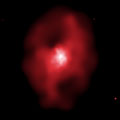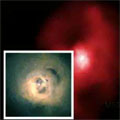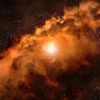An overview of the Chandra mission and goals, Chandra's namesake, top 10 facts.
Classroom activities, printable materials, interactive games & more.
Overview of X-ray Astronomy and X-ray sources: black holes to galaxy clusters.
All Chandra images released to the public listed by date & by category
Current Chandra press releases, status reports, interviews & biographies.
A collection of multimedia, illustrations & animations, a glossary, FAQ & more.
A collection of illustrations, animations and video.
Chandra discoveries in an audio/video format.
How Black Holes Both Consume and Eject Material
January 5, 2005 ::
With the announcement of the most powerful eruption ever witnessed in the Universe in the galaxy cluster MS 0735.6+7421,
astronomers are seeing that how supermassive black holes eject matter is
just as interesting as how they consume it.
This discovery, as is often the case, leads to more questions: How can
black holes eject so much energy and material? Have similar eruptions
been seen, or is this some sort a cosmic loner? What does it teach us
about supermassive black holes and about the galaxies where they reside?
To begin with, it sounds illogical that black holes could even generate
massive eruptions. After all, hasn't it always been said that nothing, not
even light, can escape a black hole? This remains true, but only when
matter passes inside the "event horizon" of a
black hole. This is a black hole's point of no return, when
nothing is capable of escaping from its intense gravity. In other words,
it's what puts the "black" in "black holes."
| The Huge Scale of the Cavities |
|
To create the cavities in MS 0735, gas is being pushed away across more
than a million light years. This distance is over a billion times greater
than the size of the black hole's event horizon. This means that if the
cavities were shrunk down in size so that they spread across the
continental US, then the black hole's event horizon would be less than a
tenth of an inch across!
|
|
Matter that gets close to a black hole but remains outside the event
horizon can undergo a very different experience and is sometimes expelled
in
violent jets. Such
jets, probably originating from an energetic, magnetized, spinning disk
around the supermassive black hole, produced the enormous cavities seen in
MS 0735. The creation of these huge structures is a vivid
demonstration of the enormous power that can be generated by
supermassive
black holes.
| The Power of Gravity and Supermassive Black Holes |
|
Gravity is a very powerful force, when harnessed by supermassive black
holes. The swallowing of material by a black hole is one of the most
efficient processes in the Universe for extracting energy from matter. It
is much more efficient, for example, than the nuclear fusion that takes
place in the Sun or a nuclear weapon. About 10% of the energy (from E=mc2)
inherent in a given amount of hydrogen is released when falling into a
black hole (more than 10% for a rapidly rotating black hole). For the same
amount of hydrogen only about 0.7% of the inherent energy is released by
fusion. Super-advanced aliens would generate much more energy from sending
a star into a black hole than letting it shine for billions of years!
|
|
Scientists can calculate - based on the gigantic amounts of energy
being expelled - how much material was consumed by a black hole. In the
case of MS 0735, astronomers estimate a mass equivalent to 300 million
Suns was consumed by the black hole. This is a gargantuan amount of
material, intriguingly as large as another supermassive black hole.
But, knowing the size of the feast does not identify its contents and
astronomers are not sure what was swallowed by the black hole in MS
0735. One possibility is that it comes from the enormous reservoir of
hot gas visible in the Chandra image. If the hot gas in the inner part
of the galaxy cluster was able to cool down quickly enough, it could
collapse onto the black hole in vast amounts. In this scenario, as the
sinking gas fed the swirling disk around the black hole, energy released
through the erupting jets would then reheat the remaining gas in the
cluster. As the energy from the eruption dies down, the gas would start
cooling again until this whole process repeats itself.
This scenario could help address a mystery in the life cycle of
galaxies. That's because astronomers expect, without the black hole as a
heat source, the hot gas near the center of the cluster should keep
cooling until it eventually forms many, many new stars. The
problem is that astronomers are not finding this excess of stars.
Therefore, it may turn out that what these black holes eat might be the
key to understanding several different fields of astrophysics: the
evolution of supermassive black holes and the evolution of galaxies and
the clusters they inhabit. The dining habits of black holes may
influence all three of these fields.
How does the powerful eruption in MS 0735 compare with events seen in other
galaxy clusters? Sometimes the Chandra images show no evidence at all for
energetic events. But, recent Chandra observations have shown evidence for
extremely powerful eruptions in both Hercules A and
Hydra A (with masses of
170 million and 50 million Suns swallowed respectively). The size, energy
and power of the cavities in MS 0735 are the largest of the three, but the
others are not far behind.
The large size of these cosmic meals comes as a surprise. A recent study
suggests that other large black holes have grown very little in the recent
past, and that only smaller black holes are still growing quickly. These
three black holes have had the ultimate super-sized meals, just when
everyone was ready to believe that they are on starvation diets.
A much less powerful system of cavities is found in the
Perseus cluster. This cluster earned widespread recognition because
Chandra determined that the black hole is generating the deepest "note"
detected in the Universe. More than just being impressive acoustically,
these sound waves are more good evidence for the cycle of cooling, black
hole-jet eruptions, heating of gas, followed by more cooling, etc.
The cavities in Perseus required large amounts of energy to form, but they
are puny compared to the ones in MS 0735. The cavities in MS 0735 are over
10 times larger in physical size and they are
expected to get bigger, unlike with Perseus. Even more impressively, about
250 times more energy was required to generate the MS 0735 cavities. All
of this is not to say that the supermassive black hole in Perseus is a
wimp, just that it has a very different diet: a lot of small, evenly spaced
meals instead of occasional feasts.
An obvious follow-up question arises: what do we know about the sound in MS
0735? The sound waves in Perseus are generated when the expanding cavities
slow down below the speed of sound and push against the cluster gas. In MS
0735, the cavities are still growing at supersonic speeds, despite their
colossal size.
Sound waves may eventually be generated when the cavities
slow down. If the eruption near the supermassive black hole repeated
itself then the resulting "note" would potentially be far deeper than the
one in Perseus. However, no tell-tale ripples are visible in the Chandra
image.
Because the cavities are so large in MS 0735, they extend almost to the
edge of the observed extent of the hot gas cloud in this cluster. Outside
the cavities the X-rays are so faint that even extremely long observations
with Chandra might never detect any ripples due to sound waves. In a sense
the eruption may simply be too powerful to allow a detection of MS 0735's
note.
Intriguingly, very little was known about these cavity systems before
Chandra was launched.
X-ray vision is needed to see the hot gas in
these clusters and Chandra's exquisitely detailed images are needed to
clearly see the giant cavities and to understand the magnitude of the
outbursts required to produce them. With many more clusters and black
holes to be observed by Chandra, who knows what exciting discoveries
will be found in the future?








